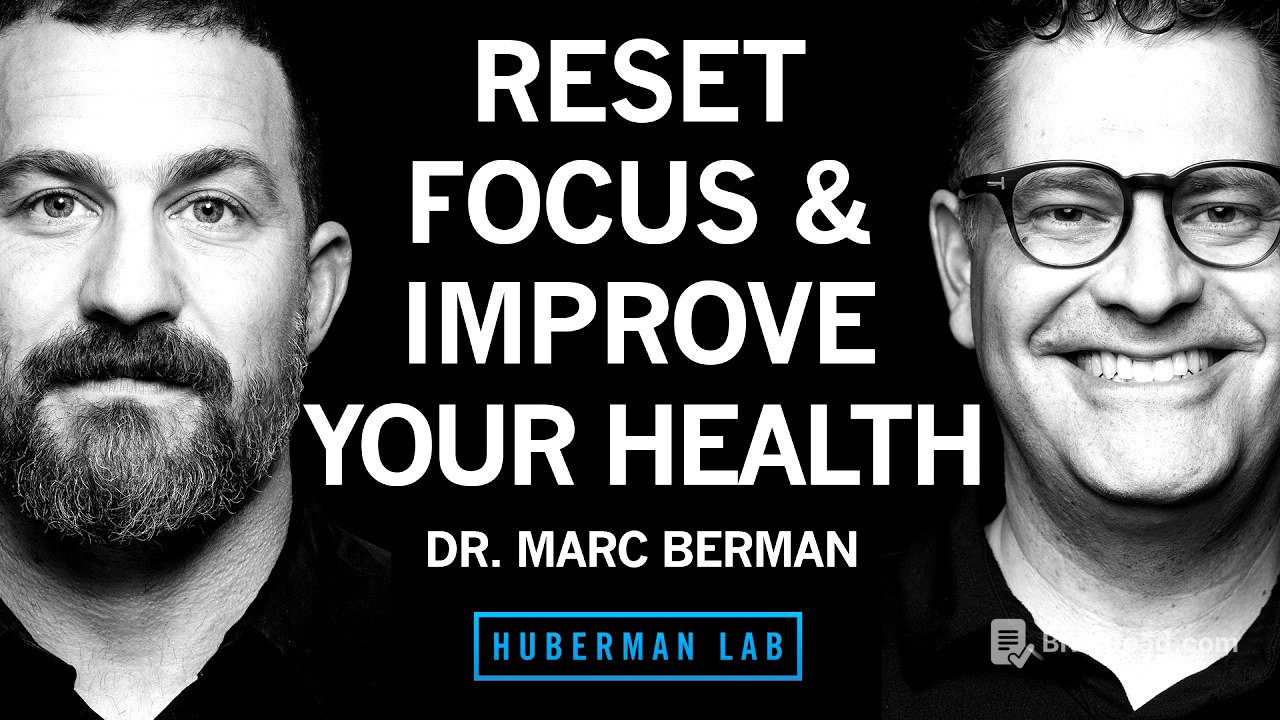TLDR;
This podcast episode with Dr. Mark Berman explores the science behind how nature impacts brain function, mental health, and cognitive performance. Key points include:
- Attention Restoration Theory: Explains how natural environments restore cognitive resources depleted by directed attention fatigue.
- Fractal Patterns: Common in nature, these patterns increase focus and reduce stress.
- Practical Strategies: Learn how to design indoor spaces and optimise nature exposure for cognitive and health benefits.
Marc Berman [0:00]
Dr. Mark Berman, a professor of psychology and director of the environmental neuroscience laboratory at the University of Chicago, studies the impact of physical environments, especially natural ones, on brain function, mental health, and cognitive performance. The discussion will cover how interactions with nature can affect the brain, stress levels, and rumination.
Direct vs Involuntary Attention, Mental Fatigue, Attention Restoration Theory [2:14]
Attention is fundamental to controlling behaviours, and its depletion can lead to reduced impulse control and difficulty achieving goals. Directed attention, a uniquely human capability, involves consciously choosing what to focus on but is susceptible to fatigue. Involuntary attention, automatically captured by interesting stimuli, is less prone to depletion. Modern life often fatigues directed attention, making it difficult to recharge. Attention Restoration Theory suggests that environments that softly capture involuntary attention can restore directed attention.
Attention Fatigue, Focus & Vision, Tool: Restoring Attention in Nature [6:59]
The neurological basis of attentional fatigue is not fully understood, but directed attention is likely centred in the frontal cortex, while involuntary attention involves the parietal and occipital cortices. Restricting the visual field can aid focus by limiting involuntary attention. Taking breaks, especially in nature, is crucial for recharging directed attention, as social media scrolling is not restorative.
Sponsors: Helix Sleep & BetterHelp [11:26]
This section acknowledges sponsors Helix Sleep and BetterHelp, emphasising the importance of quality sleep and therapy for mental and physical health.
Focused Work, Tool: Pre-Work Nature Breaks to Enhance Focus [13:50]
Many people struggle to enter a focused state, experiencing agitation and distraction. A walk in nature can serve as a preparatory process, similar to warming up before exercise, by engaging involuntary attention and recharging cognitive resources. Interacting with and noticing nature is key to this process.
Nature Walks & Cognitive Benefits, Comparing Nature vs Urban Environments [15:54]
Laboratory data supports the cognitive benefits of nature walks. A study in 2008 demonstrated that participants' working memory capacity and ability to direct attention improved by approximately 20% after a walk in nature compared to an urban environment. This improvement occurred regardless of whether participants enjoyed the walk, suggesting that the benefits are not solely mood-driven.
Nature, “Softly Fascinating Stimulation”, Fractals [21:31]
Nature walks enhance directed attention by not demanding focused attention and by providing softly fascinating stimulation. Soft fascination involves capturing involuntary attention without overwhelming it, allowing for mind-wandering. Unlike the harsh fascination of environments like Times Square, nature's colours, fractal patterns, and curved edges softly capture attention.
Nature Images & Sounds, Cognitive Benefits [27:12]
Exposure to nature images and sounds can improve cognitive performance, although the effects are not as strong as those from actual nature walks. This suggests that the visual aesthetic of nature plays a role in restoring directed attention.
Urban vs Nature Images, Complexity & Image Compression; Semantics [30:03]
The brain may have areas or circuits specifically tuned to nature, processing natural stimulation more fluently. Nature scenes are more compressible than urban scenes due to repeated patterns, requiring less information storage. Semantically, nature is simpler, with a smaller language repertoire compared to the complex vocabulary needed to describe urban environments.
Time Perception & Nature; Art Galleries [40:44]
People tend to think more about the past when walking in nature, suggesting that time may slow down. Art galleries, like nature, can be restorative by providing softly fascinating stimulation without demanding directed attention. Park visits, but not museum visits, are linked to reduced crime, suggesting a unique impact of nature on aggression.
Tools: Resetting Attention & Nature Break; Features of a Restorative Nature Environments vs Focused Workspace; Length of Time in Nature [45:32]
To reset attentional abilities, be mindful of directed attention fatigue and take breaks in nature. If focus is difficult from the start, begin the day with a nature walk or simulated nature exposure. Restorative environments should have extent (interesting things to look at), compatibility with goals, and a sense of being away. Designate separate areas for deep work. Cognitive enhancement can occur with as little as 20 minutes in nature, with about 2 hours a week being optimal.
Sponsors: AG1 & Our Place [52:47]
This section acknowledges sponsors AG1 and Our Place, highlighting their products' benefits for health and well-being.
Nature, Time & Widening Attention; Fractals & Nature [55:59]
Being in nature widens the cognitive landscape, aiding problem-solving. Visual environments like nature encourage panoramic vision, taking in larger "pixels" of the environment. Nature's sparse yet rich elements trigger unique cognitive networks. Fractals, common in nature, exhibit repeated patterns at different scales, potentially easing brain processing.
Nature vs Urban Environments & Brain, Social Media & Attention [1:02:21]
Social media is not fractal and presents cognitive chaos, bombarding users with sensory information and preventing the brain from reaching a restful, fractal state. Social media platforms are designed to capture directed attention, often leading to extended, unintended usage.
Depression & Rumination, Mental Well-Being, Attention & Nature [1:09:44]
Nature can provide attentional resources to manage rumination, as demonstrated by stronger working memory benefits in clinically depressed participants who were induced to ruminate before walking in nature. Distraction is detrimental, while being fully present is the basis of a great life.
Sleep vs Wakefulness; Protecting Attention, Social Media [1:14:56]
Protecting directed attention is crucial, and social media should be used mindfully. High-fractal environments, like nature, may be as essential as sleep for resetting the brain. Understanding and engaging in proper waking states can improve lives, irrespective of medication needs.
Sponsor: LMNT [1:24:44]
This section acknowledges sponsor LMNT, highlighting the importance of electrolytes for hydration and bodily function.
Impulsivity, Texting & Attention, Meditation vs Nature Restoration [1:26:19]
Impulsivity is common, exemplified by frequent phone use. Texting, like social media, likely depletes directed attention. Multimedia multitasking does not train attention but depletes it. Mindfulness meditation is focus training, while nature walks are a reset.
Passive Restorative vs Passive Depleting Activities, “Mental Obesity”, Shrinking Attention Span [1:33:10]
It's important to distinguish between passive restorative and passive depleting activities. Repeated passive depleting activities can lead to "mental obesity," weakening the circuitry for directed attention. Collective attention spans may be shrinking, raising concerns about individual directed attention.
Kids, Phones, Tool: Nature Free Play; Social Happy Hour, Tool: Solitary Nature Breaks [1:37:31]
Encourage kids to engage in free play in nature to build and reinforce cognitive circuits. Taking breaks in nature allows for more hard things to be done. Social happy hours may be good socially, but not necessarily for directed attention. Solitary nature experiences are most restorative.
Physical Health Benefits of Nature, Trees & Indoor Greenery; Aquariums [1:45:30]
Nature has physical health benefits, such as faster recovery from surgery and reduced need for pain medication. Increased tree canopy in neighbourhoods is linked to improved health perceptions and reduced stroke, diabetes, and heart disease. Indoor plants and greenery can also provide attention benefits and reduce feelings of pain. Aquariums can be passive and restorative.
Thoughts, Feelings & Physical Spaces, Biophilic Design, Bringing Nature Indoors [1:53:26]
People perceive nature in architectural scenes, preferring designs that mimic natural patterns. Parks with more curved edges are associated with increased reflections on spirituality. Visual scenes profoundly impact cognition.
Nature Breaks, Incorporating Nature into Schools, Work, Home & Cities; Forest Bathing [2:01:03]
People need to get out into nature more, especially when mentally fatigued, and treat it as a necessity, not just an amenity. Schools and workplaces should incorporate more nature breaks. Cities should integrate natural elements into built spaces.
Zero-Cost Support, YouTube, Spotify & Apple Follow & Reviews, Sponsors, YouTube Feedback, Protocols Book, Social Media, Neural Network Newsletter [2:09:18]
Support the podcast by subscribing to the YouTube channel, following on Spotify and Apple, leaving reviews, and checking out the sponsors. Provide feedback in the YouTube comment section. The book "Protocols: An Operating Manual for the Human Body" is available for pre-sale. Follow Huberman Lab on social media and subscribe to the neural network newsletter for more science-based tools and information.









